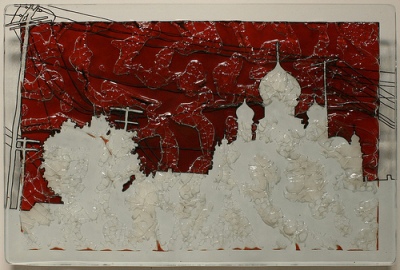 Scott Goss, Cityscape Series #83, 2010. Glass, enamel, copper. H 12, W 18 in. courtesy: society for contemporary craft
Scott Goss, Cityscape Series #83, 2010. Glass, enamel, copper. H 12, W 18 in. courtesy: society for contemporary craft
Many of the cities that make up the rust belt that skirts the southern shores of the Great Lakes have seen the great industrial buildings and factories that once brought the area prosperity go dark. Few major cities in this part of the country were spared the shuttered factories and entire stretches of town that look positively apocalyptic. Artist Scott Goss, a Cleveland native, knows these visions intimately and they form the basis of his new solo exhibition City Unseen, currently on display at Society of Contemporary Craft’s BNY Mellon satellite gallery in downtown Pittsburgh through October 9th.
 Scott Goss, St. Clair, 2011. Glass, enamel, copper. H 18, W 27 in. courtesy: society for contemporary craft
Scott Goss, St. Clair, 2011. Glass, enamel, copper. H 18, W 27 in. courtesy: society for contemporary craft
Through a process that involves glass painting, fusing and slumping onto copper plates, Goss seeks out visions of urban decay. “By using thought-provoking photography I document the architecture in forgotten parts of these cities…I strive to bring awareness to, and inspire dialogue about, the issues concerning urban decay,” he writes in his artist statement. Indeed the industrial settings are usually seen in black or white, the crossed wires, steel beams and girders, and deserted buildings pop out in front of deep red, blue, and orange skies.
The word, “pop” is a very apt description for the effect these pieces have on the viewer. His use of raised glass in the work calls to mind impasto painting, and creates a link between his flat panel glass compositions and more traditional studio glass sculpture. Goss’s evocation of impasto also creates interesting thematic connections to other schools of painting associated with use of the technique, chiefly impressionism. Impressionism’s preoccupation with landscapes and pastoral scenes provides an interesting counterpoint to Goss’ work, which, through the pieces’ highlighting of the vividly colored skies, implies that these closed factories and crisscrossing power lines are now a part of the American landscape.
 Scott Goss, St. Theodosius 2/10, 2011. Glass, enamel, copper. 8" x 12" photo courtesy: society for contemporary craft
Scott Goss, St. Theodosius 2/10, 2011. Glass, enamel, copper. 8" x 12" photo courtesy: society for contemporary craft
Perhaps the most interesting pieces in the exhibition are a series of pieces called, “St. Theodosius,” which depict crossed electrical wires and telephone poles in front of Cleveland’s St. Theodosius Orthodox Cathedral. “In the aftermath of urban flight, remaining residents are often left with a feeling of hopelessness and abandonment, as they attempt to salvage what remains of their cities,” writes Goss. Seen in this context, alongside images of urban decay, Goss’ ambiguous relationship to the cathedral he is depicting leaves the viewer with questions about religion and its place in modern American society. In times of “hopelessness,” Goss opines, a past retreat has always been into the embrace of the church. But a procative question that these pieces bring up is whether the church is another crumbling piece of the American landscape, and if so who abandoned whom?
Goss, a 2006 graduate from The Cleveland Institute or Art’s glass program, has amassed a quite impressive CV for someone who is still in the midst of his MFA studies (he expects to graduate from Kent State University with an MFA in glass in 2013). He showed work in five solo or duo shows, he has shown work in over thirty group shows (including Urban Glass’ Fete de Verre show earlier this year), and was commissioned to create the prizes for the 35th Annual Cleveland Film Festival.
-Jason Gutierrez
 Scott Goss, Above and Below, 2011. Glass, enamel, copper. H 26, W 39in. courtesy: society for contemporary craft
Scott Goss, Above and Below, 2011. Glass, enamel, copper. H 26, W 39in. courtesy: society for contemporary craft
IF YOU GO:
Scott Goss“City Unseen”Through October 9thSociety for Contemporary Crafts Satellite Gallery at BNY Mellon CenterLobby of Steel Plaza T-Station500 Grant StreetPittsburgh, PA 15219Open daily until midnight(412) 261-7003Website: http://www.contemporarycraft.org/

